

Compact Muon Solenoid
LHC, CERN
| CMS-SUS-18-003 ; CERN-EP-2018-312 | ||
| Search for the pair production of light top squarks in the $\mathrm{e}^{\pm}\mu^{\mp}$ final state in proton-proton collisions at $\sqrt{s} = $ 13 TeV | ||
| CMS Collaboration | ||
| 4 January 2019 | ||
| JHEP 03 (2019) 101 | ||
| Abstract: A search for the production of a pair of top squarks at the LHC is presented. This search targets a region of parameter space where the kinematics of top squark pair production and top quark pair production are very similar, because of the mass difference between the top squark and the neutralino being close to the top quark mass. The search is performed with 35.9 fb$^{-1}$ of proton-proton collisions at a centre-of-mass energy of $\sqrt{s} = $ 13 TeV, collected by the CMS detector in 2016, using events containing one electron-muon pair with opposite charge. The search is based on a precise estimate of the top quark pair background, and the use of the ${M_{\textrm{T2}}}$ variable, which combines the transverse mass of each lepton and the missing transverse momentum. No excess of events is found over the standard model predictions. Exclusion limits are placed at 95% confidence level on the production of top squarks up to masses of 200 GeV for models with a mass difference between the top squark and the lightest neutralino close to that of the top quark. | ||
| Links: e-print arXiv:1901.01288 [hep-ex] (PDF) ; CDS record ; inSPIRE record ; CADI line (restricted) ; | ||
| Figures | |
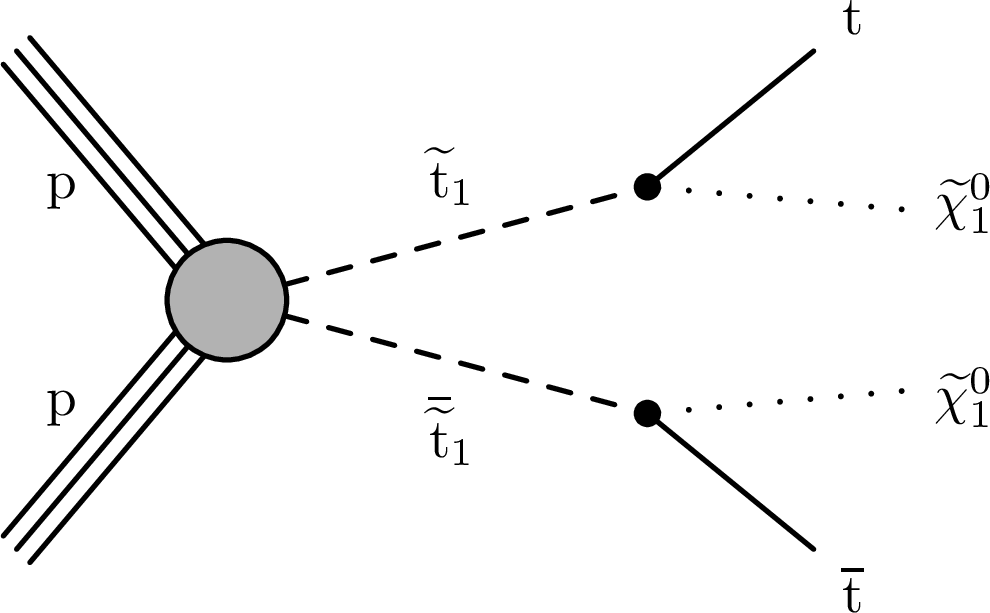
png pdf |
Figure 1:
Diagram of the top squark pair production with further decay into a top (antitop) quark and the lightest neutralino. |
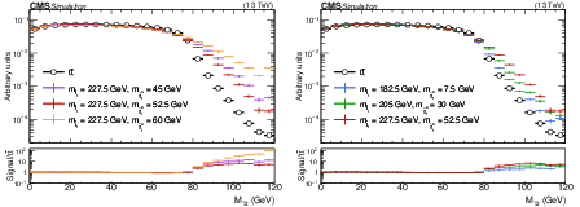
png pdf |
Figure 2:
Normalized ${M_{\textrm {T2}}}$ distributions for various mass hypotheses for the top squark and for the neutralino. Variables at the generator level are used for ${{\mathrm {t}\overline {\mathrm {t}}}}$ and signal events with two generated leptons with ${p_{\mathrm {T}}}$ of at least 20 GeV and $ {| \eta |} \leq $ 2.4. The last bin includes the overflow. |

png pdf |
Figure 2-a:
Normalized ${M_{\textrm {T2}}}$ distributions for various mass hypotheses for the top squark and for the neutralino. Variables at the generator level are used for ${{\mathrm {t}\overline {\mathrm {t}}}}$ and signal events with two generated leptons with ${p_{\mathrm {T}}}$ of at least 20 GeV and $ {| \eta |} \leq $ 2.4. The last bin includes the overflow. |

png pdf |
Figure 2-b:
Normalized ${M_{\textrm {T2}}}$ distributions for various mass hypotheses for the top squark and for the neutralino. Variables at the generator level are used for ${{\mathrm {t}\overline {\mathrm {t}}}}$ and signal events with two generated leptons with ${p_{\mathrm {T}}}$ of at least 20 GeV and $ {| \eta |} \leq $ 2.4. The last bin includes the overflow. |

png pdf |
Figure 3:
Distributions for leading and subleading lepton ${p_{\mathrm {T}}}$, $\Delta \phi ({\mathrm {e}}, {{\mu}})$, and ${{p_{\mathrm {T}}} ^\text {miss}}$. The uncertainty band includes statistical and all systematic uncertainties described in Section 7. The last bin contains the overflow events. The signal is stacked on top of the background prediction for a mass hypothesis of $ {{m}_{\tilde{\mathrm {t}}_1}} = $ 175 GeV and $ {{m}_{{\tilde{\chi}^{0}_{1}}}} = $ 1 GeV. |
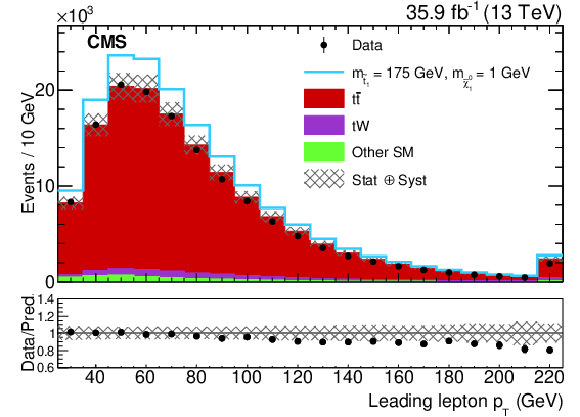
png pdf |
Figure 3-a:
Distribution for the leading lepton ${p_{\mathrm {T}}}$. The uncertainty band includes statistical and all systematic uncertainties described in Section 7. The last bin contains the overflow events. The signal is stacked on top of the background prediction for a mass hypothesis of $ {{m}_{\tilde{\mathrm {t}}_1}} = $ 175 GeV and $ {{m}_{{\tilde{\chi}^{0}_{1}}}} = $ 1 GeV. |

png pdf |
Figure 3-b:
Distribution for the subleading lepton ${p_{\mathrm {T}}}$. The uncertainty band includes statistical and all systematic uncertainties described in Section 7. The last bin contains the overflow events. The signal is stacked on top of the background prediction for a mass hypothesis of $ {{m}_{\tilde{\mathrm {t}}_1}} = $ 175 GeV and $ {{m}_{{\tilde{\chi}^{0}_{1}}}} = $ 1 GeV. |

png pdf |
Figure 3-c:
Distribution for $\Delta \phi ({\mathrm {e}} {{\mu}})$. The uncertainty band includes statistical and all systematic uncertainties described in Section 7. The last bin contains the overflow events. The signal is stacked on top of the background prediction for a mass hypothesis of $ {{m}_{\tilde{\mathrm {t}}_1}} = $ 175 GeV and $ {{m}_{{\tilde{\chi}^{0}_{1}}}} = $ 1 GeV. |
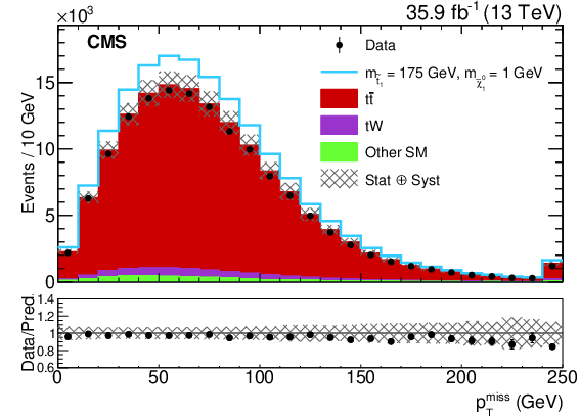
png pdf |
Figure 3-d:
Distribution for ${{p_{\mathrm {T}}} ^\text {miss}}$. The uncertainty band includes statistical and all systematic uncertainties described in Section 7. The last bin contains the overflow events. The signal is stacked on top of the background prediction for a mass hypothesis of $ {{m}_{\tilde{\mathrm {t}}_1}} = $ 175 GeV and $ {{m}_{{\tilde{\chi}^{0}_{1}}}} = $ 1 GeV. |
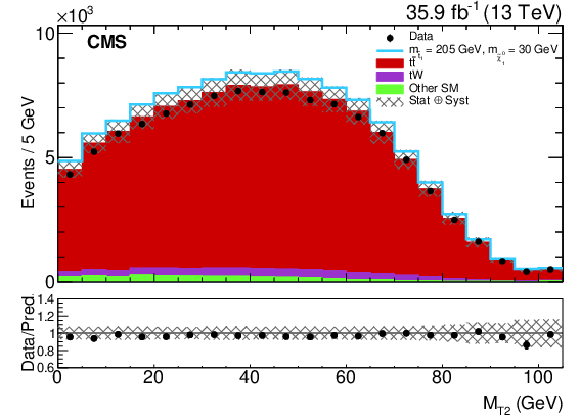
png pdf |
Figure 4:
${M_{\textrm {T2}}}$ distribution (prefit) for data and predicted background. The ${M_{\textrm {T2}}}$ distribution for a signal corresponding to a top squark mass of 205 GeV and a neutralino mass of 30 GeV is also shown, stacked on top of the background estimate. The hatched bands correspond to the combined systematic and statistical uncertainties on background rates. The last bin of the histogram includes the overflow events. The lower pane shows the ratio between the observed data and the predicted SM background. |

png pdf |
Figure 5:
Expected and observed upper limits at 95% CL on the signal strength as a function of the top squark mass for $ {{m}_{\tilde{\mathrm {t}}_1}} - {{m}_{{\tilde{\chi}^{0}_{1}}}} = $ 175 GeV (upper left), $ {{m}_{\tilde{\mathrm {t}}_1}}- {{m}_{{\tilde{\chi}^{0}_{1}}}} = $ 167.5 GeV (upper right) and $ {{m}_{\tilde{\mathrm {t}}_1}}- {{m}_{{\tilde{\chi}^{0}_{1}}}} = $ 182.5 GeV (lower). The green dark and yellow light bands correspond to the 68 and 95% CL ranges of the expected upper limits. |
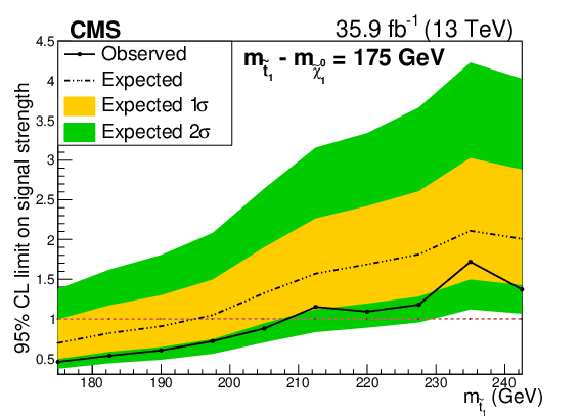
png pdf |
Figure 5-a:
Expected and observed upper limits at 95% CL on the signal strength as a function of the top squark mass for $ {{m}_{\tilde{\mathrm {t}}_1}} - {{m}_{{\tilde{\chi}^{0}_{1}}}} = $ 175 GeV. The green dark and yellow light bands correspond to the 68 and 95% CL ranges of the expected upper limits. |
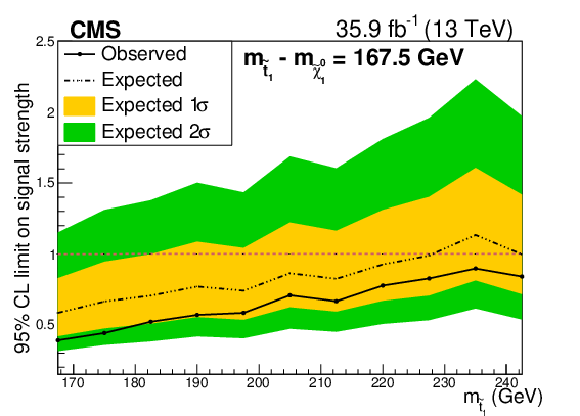
png pdf |
Figure 5-b:
Expected and observed upper limits at 95% CL on the signal strength as a function of the top squark mass for $ {{m}_{\tilde{\mathrm {t}}_1}}- {{m}_{{\tilde{\chi}^{0}_{1}}}} = $ 167.5 GeV. The green dark and yellow light bands correspond to the 68 and 95% CL ranges of the expected upper limits. |
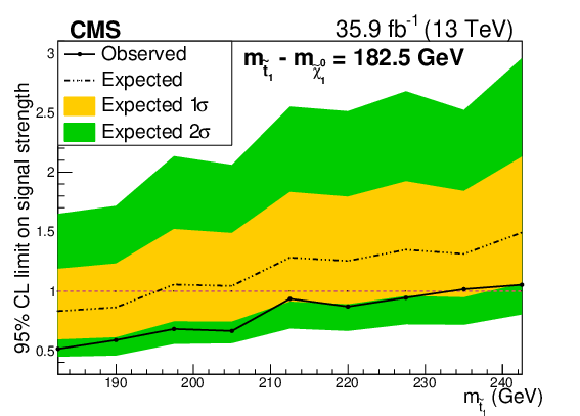
png pdf |
Figure 5-c:
Expected and observed upper limits at 95% CL on the signal strength as a function of the top squark mass for $ {{m}_{\tilde{\mathrm {t}}_1}}- {{m}_{{\tilde{\chi}^{0}_{1}}}} = $ 182.5 GeV. The green dark and yellow light bands correspond to the 68 and 95% CL ranges of the expected upper limits. |
| Tables | |
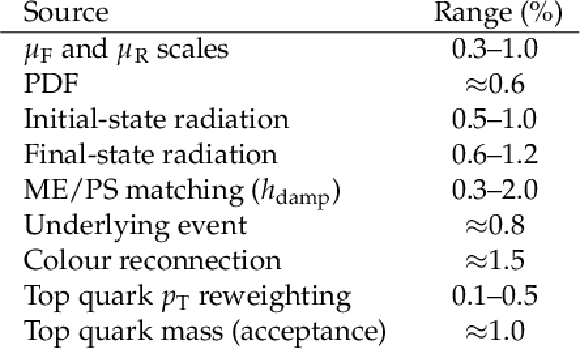
png pdf |
Table 1:
Summary of the uncertainties on the ${M_{\textrm {T2}}}$ distribution resulting from ${{\mathrm {t}\overline {\mathrm {t}}}}$ background modelling uncertainties. The ranges correspond to variations of the uncertainty along the ${M_{\textrm {T2}}}$ distribution. When only one number is shown, the uncertainty is approximately constant over the entire ${M_{\textrm {T2}}}$ range. |

png pdf |
Table 2:
Summary of the uncertainties in ${{\mathrm {t}\overline {\mathrm {t}}}}$ background and signal simulation resulting from experimental uncertainties. The numbers represent typical values of the uncertainties in the signal and ${{\mathrm {t}\overline {\mathrm {t}}}}$ background yields or ranges for these uncertainties in different ${M_{\textrm {T2}}}$ bins and in different signal samples. |
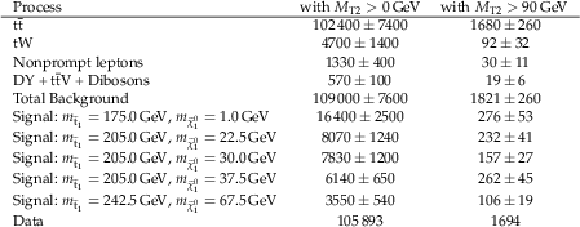
png pdf |
Table 3:
Number of expected and observed events after the selection, with $ {M_{\textrm {T2}}} > 0$ and $ {M_{\textrm {T2}}} > $ 90 GeV. The quoted uncertainties reflect both the statistical and systematic contributions. |
| Summary |
|
A search is presented for a top squark with a mass difference from the neutralino mass close to the top quark mass, ${{m}_{\tilde{\mathrm{t}}_{1}}} - {{m}_{\tilde{\chi}^0_1}} \approx {m_{\mathrm{t}}} $, using events with one opposite-sign electron-muon pair, at least two jets, and at least one b jet. The $\tilde{\mathrm{t}}_{1}\to\mathrm{t}\tilde{\chi}^0_1$ decay mode is considered, and different top squark masses are explored up to 240 GeV with neutralino masses of ${{m}_{\tilde{\chi}^0_1}} \approx {{m}_{\tilde{\mathrm{t}}_{1}}} - {m_{\mathrm{t}}} $. The ${M_{\textrm{T2}}}$ variable is used in a binned profile likelihood fit to increase the sensitivity, owing to the different kinematic distributions between the signal and the $\mathrm{t\bar{t}}$ background. Further sensitivity is gained from the absence of a kinematic endpoint in this variable for the signal. No excess is observed and upper limits are set at 95% confidence level on the top squark production cross section for top squark masses up to 210 GeV in models with ${{m}_{\tilde{\mathrm{t}}_{1}}} - {{m}_{\tilde{\chi}^0_1}} \approx {m_{\mathrm{t}}} $ and masses up to 240 GeV in models with a mass difference of 7.5 GeV. This result significantly extends the exclusion limits of top squark searches at the LHC to higher top squark masses in the region where ${{m}_{\tilde{\mathrm{t}}_{1}}} - {{m}_{\tilde{\chi}^0_1}} \approx {m_{\mathrm{t}}} $, that was previously unexplored. |
| References | ||||
| 1 | R. Barbieri and G. F. Giudice | Upper bounds on supersymmetric particle masses | NPB 306 (1988) 63 | |
| 2 | E. Witten | Dynamical breaking of supersymmetry | NPB 188 (1981) 513 | |
| 3 | G. Bertone, D. Hooper, and J. Silk | Particle dark matter: evidence, candidates and constraints | PR 405 (2005) 279 | 1304.0790 |
| 4 | J. L. Feng | Dark matter candidates from particle physics and methods of detection | Ann. Rev. Astron. Astrophys. 48 (2010) 495 | 1003.0904 |
| 5 | P. Ramond | Dual theory for free fermions | PRD 3 (1971) 2415 | |
| 6 | Y. A. Golfand and E. P. Likhtman | Extension of the algebra of Poincar$ \'e $ group generators and violation of P invariance | JEPTL 13 (1971)323 | |
| 7 | A. Neveu and J. H. Schwarz | Factorizable dual model of pions | NPB 31 (1971) 86 | |
| 8 | D. V. Volkov and V. P. Akulov | Possible universal neutrino interaction | JEPTL 16 (1972)438 | |
| 9 | J. Wess and B. Zumino | A Lagrangian model invariant under supergauge transformations | PLB 49 (1974) 52 | |
| 10 | J. Wess and B. Zumino | Supergauge transformations in four-dimensions | NPB 70 (1974) 39 | |
| 11 | P. Fayet | Supergauge invariant extension of the Higgs mechanism and a model for the electron and its neutrino | NPB 90 (1975) 104 | |
| 12 | H. P. Nilles | Supersymmetry, supergravity and particle physics | PR 110 (1984) 1 | |
| 13 | S. P. Martin | A supersymmetry primer | Adv. Ser. Direct. High Energy Phys. 18 (1998) 1 | hep-ph/9709356 |
| 14 | R. K. Kaul and P. Majumdar | Cancellation of quadratically divergent mass corrections in globally supersymmetric spontaneously broken gauge theories | NPB 199 (1982) 36 | |
| 15 | S. Dimopoulos and H. Georgi | Softly broken supersymmetry and SU(5) | NPB 193 (1981) 150 | |
| 16 | G. R. Farrar and P. Fayet | Phenomenology of the production, decay, and detection of new hadronic states associated with supersymmetry | PLB 76 (1978) 575 | |
| 17 | M. Czakon et al. | Closing the stop gap | PRL 113 (2014) 201803 | 1407.1043 |
| 18 | ATLAS Collaboration | Search for direct top squark pair production in final states with two leptons in $ \sqrt{s} = $ 13 TeV pp collisions with the ATLAS detector | EPJC 77 (2017) 898 | 1708.03247 |
| 19 | ATLAS Collaboration | ATLAS Run 1 searches for direct pair production of third-generation squarks at the Large Hadron Collider | EPJC 75 (2015) 510 | 1506.08616 |
| 20 | ATLAS Collaboration | Search for top squark pair production in final states with one isolated lepton, jets, and missing transverse momentum in $ \sqrt s = $ 8 TeV pp collisions with the ATLAS detector | JHEP 11 (2014) 118 | 1407.0583 |
| 21 | ATLAS Collaboration | Search for direct top-squark pair production in final states with two leptons in pp collisions at $ \sqrt{s} = $ 8 TeV with the ATLAS detector | JHEP 06 (2014) 124 | 1403.4853 |
| 22 | ATLAS Collaboration | Search for top squarks in final states with one isolated lepton, jets, and missing transverse momentum in $ \sqrt{s}= $ 13 TeV pp collisions with the ATLAS detector | PRD 94 (2016) 052009 | 1606.03903 |
| 23 | CMS Collaboration | Search for top squark pair production in pp collisions at $ \sqrt{s}= $ 13 TeV using single lepton events | JHEP 10 (2017) 019 | CMS-SUS-16-051 1706.04402 |
| 24 | CMS Collaboration | Search for top squarks and dark matter particles in opposite-charge dilepton final states at $ \sqrt{s}= $ 13 TeV | PRD 97 (2018) 032009 | CMS-SUS-17-001 1711.00752 |
| 25 | CMS Collaboration | Search for top-squark pair production in the single-lepton final state in pp collisions at $ \sqrt{s} = $ 8 TeV | EPJC 73 (2013) 2677 | CMS-SUS-13-011 1308.1586 |
| 26 | CMS Collaboration | Search for direct pair production of scalar top quarks in the single- and dilepton channels in proton-proton collisions at $ \sqrt{s} = $ 8 TeV | JHEP 07 (2016) 027 | CMS-SUS-14-015 1602.03169 |
| 27 | CMS Collaboration | Search for top squark pair production in compressed-mass-spectrum scenarios in proton-proton collisions at $ \sqrt{s} = $ 8 TeV using the $ \alpha_{\mathrm{T}} $ variable | PLB 767 (2017) 403 | CMS-SUS-14-006 1605.08993 |
| 28 | CMS Collaboration | Searches for pair production of third-generation squarks in $ \sqrt{s}= $ 13 TeV pp collisions | EPJC 77 (2017) 327 | CMS-SUS-16-008 1612.03877 |
| 29 | CMS Collaboration | Search for direct production of supersymmetric partners of the top quark in the all-jets final state in proton-proton collisions at $ \sqrt{s}= $ 13 TeV | JHEP 10 (2017) 005 | CMS-SUS-16-049 1707.03316 |
| 30 | CMS Collaboration | Search for supersymmetry in proton-proton collisions at 13 TeV using identified top quarks | PRD 97 (2018) 012007 | CMS-SUS-16-050 1710.11188 |
| 31 | CMS Collaboration | Measurement of the $ \mathrm{t\bar{t}} $ production cross section in the e$ \mu $ channel in proton-proton collisions at $ \sqrt{s} = $ 7 and 8 TeV | JHEP 08 (2016) 029 | CMS-TOP-13-004 1603.02303 |
| 32 | ATLAS Collaboration | Measurement of the $ \mathrm{t\bar{t}} $ production cross-section using $ e\mu $ events with b-tagged jets in pp collisions at $ \sqrt{s} = $ 7 and 8 $ \mathrm{TeV} $ with the ATLAS detector | EPJC 74 (2014) 3109 | 1406.5375 |
| 33 | ATLAS Collaboration | Measurement of spin correlation in top-antitop quark events and search for top squark pair production in pp collisions at $ \sqrt{s}= $ 8 TeV using the ATLAS detector | PRL 114 (2015) 142001 | 1412.4742 |
| 34 | CMS Collaboration | The CMS trigger system | JINST 12 (2017) P01020 | CMS-TRG-12-001 1609.02366 |
| 35 | CMS Collaboration | The CMS experiment at the CERN LHC | JINST 3 (2008) S08004 | CMS-00-001 |
| 36 | S. Alioli et al. | A general framework for implementing NLO calculations in shower Monte Carlo programs: the POWHEG BOX | JHEP 06 (2010) 043 | 1002.2581 |
| 37 | S. Frixione, P. Nason, and C. Oleari | Matching NLO QCD computations with Parton Shower simulations: the POWHEG method | JHEP 11 (2007) 070 | 0709.2092 |
| 38 | P. Nason | A new method for combining NLO QCD with shower Monte Carlo algorithms | JHEP 11 (2004) 040 | hep-ph/0409146 |
| 39 | CMS Collaboration | Investigations of the impact of the parton shower tuning in Pythia 8 in the modelling of $ \mathrm{t\overline{t}} $ at $ \sqrt{s}= $ 8 and 13 TeV | CMS-PAS-TOP-16-021 | CMS-PAS-TOP-16-021 |
| 40 | E. Re | Single-top Wt-channel production matched with parton showers using the POWHEG method | EPJC 71 (2011) 1547 | 1009.2450 |
| 41 | J. Alwall et al. | The automated computation of tree-level and next-to-leading order differential cross sections, and their matching to parton shower simulations | JHEP 07 (2014) 079 | 1405.0301 |
| 42 | R. Frederix and S. Frixione | Merging meets matching in MC@NLO | JHEP 12 (2012) 061 | 1209.6215 |
| 43 | T. Sjostrand et al. | An introduction to PYTHIA 8.2 | CPC 191 (2015) 159 | 1410.3012 |
| 44 | J. Alwall, P. Schuster, and N. Toro | Simplified models for a first characterization of new physics at the LHC | PRD 79 (2009) 075020 | 0810.3921 |
| 45 | LHC New Physics Working Group Collaboration | Simplified models for LHC new physics searches | JPG 39 (2012) 105005 | 1105.2838 |
| 46 | NNPDF Collaboration | Parton distributions for the LHC Run II | JHEP 04 (2015) 040 | 1410.8849 |
| 47 | CMS Collaboration | Event generator tunes obtained from underlying event and multiparton scattering measurements | EPJC 76 (2016) 155 | CMS-GEN-14-001 1512.00815 |
| 48 | GEANT4 Collaboration | GEANT4--a simulation toolkit | NIMA 506 (2003) 250 | |
| 49 | Y. Li and F. Petriello | Combining QCD and electroweak corrections to dilepton production in the framework of the FEWZ simulation code | PRD 86 (2012) 094034 | 1208.5967 |
| 50 | N. Kidonakis | Theoretical results for electroweak-boson and single-top production | PoS DIS2015 (2015) 170 | 1506.04072 |
| 51 | J. M. Campbell, R. K. Ellis, and C. Williams | Vector boson pair production at the LHC | JHEP 07 (2011) 018 | 1105.0020 |
| 52 | M. V. Garzelli, A. Kardos, C. G. Papadopoulos, and Z. Trocsanyi | $ \mathrm{t\bar{t}}\mathrm{W}$ and $\mathrm{t\bar{t}}\mathrm{Z}$ hadroproduction at NLO accuracy in QCD with parton shower and hadronization effects | JHEP 11 (2012) 056 | 1208.2665 |
| 53 | M. Czakon, P. Fiedler, and A. Mitov | Total top-quark pair-production cross section at hadron colliders through O($ {\alpha_S}^4 $) | PRL 110 (2013) 252004 | 1303.6254 |
| 54 | M. Czakon and A. Mitov | Top++: A program for the calculation of the top-pair cross-section at hadron colliders | CPC 185 (2014) 2930 | 1112.5675 |
| 55 | C. Borschensky et al. | Squark and gluino production cross sections in pp collisions at $ \sqrt{s} = $ 13, 14, 33 and 100 TeV | EPJC 74 (2014) 3174 | 1407.5066 |
| 56 | W. Beenakker et al. | Squark and gluino hadroproduction | Int. J. Mod. Phys. A 26 (2011) 2637 | 1105.1110 |
| 57 | W. Beenakker et al. | Soft-gluon resummation for squark and gluino hadroproduction | JHEP 12 (2009) 041 | 0909.4418 |
| 58 | A. Kulesza and L. Motyka | Soft gluon resummation for the production of gluino-gluino and squark-antisquark pairs at the LHC | PRD 80 (2009) 095004 | 0905.4749 |
| 59 | A. Kulesza and L. Motyka | Threshold resummation for squark-antisquark and gluino-pair production at the LHC | PRL 102 (2009) 111802 | 0807.2405 |
| 60 | W. Beenakker, R. Hopker, M. Spira, and P. M. Zerwas | Squark and gluino production at hadron colliders | NPB 492 (1997) 51 | hep-ph/9610490 |
| 61 | CMS Collaboration | Particle-flow reconstruction and global event description with the CMS detector | JINST 12 (2017) P10003 | CMS-PRF-14-001 1706.04965 |
| 62 | M. Cacciari, G. P. Salam, and G. Soyez | The anti-$ {k_{\mathrm{T}}} $ jet clustering algorithm | JHEP 04 (2008) 063 | 0802.1189 |
| 63 | M. Cacciari, G. P. Salam, and G. Soyez | FastJet user manual | EPJC 72 (2012) 1896 | 1111.6097 |
| 64 | CMS Collaboration | Performance of electron reconstruction and selection with the CMS detector in proton-proton collisions at $ \sqrt{s} = $ 8 TeV | JINST 10 (2015) P06005 | CMS-EGM-13-001 1502.02701 |
| 65 | CMS Collaboration | Jet energy scale and resolution in the CMS experiment in pp collisions at 8 TeV | JINST 12 (2017) P02014 | CMS-JME-13-004 1607.03663 |
| 66 | CMS Collaboration | Identification of heavy-flavour jets with the CMS detector in pp collisions at 13 TeV | JINST 13 (2018) P05011 | CMS-BTV-16-002 1712.07158 |
| 67 | CMS Collaboration | Performance of the CMS muon detector and muon reconstruction with proton-proton collisions at $ \sqrt{s}= $ 13 TeV | JINST 13 (2018) P06015 | CMS-MUO-16-001 1804.04528 |
| 68 | CMS Collaboration | Performance of missing energy reconstruction in $ \sqrt{s}= $ 13 TeV pp collision data using the CMS detector | CMS-PAS-JME-16-004 | CMS-PAS-JME-16-004 |
| 69 | CMS Collaboration | Measurement of the $ \mathrm{t\bar{t}} $ production cross section using events in the e$ \mu $ final state in pp collisions at $ \sqrt{s} = $ 13 TeV | EPJC 77 (2017) 172 | CMS-TOP-16-005 1611.04040 |
| 70 | H.-C. Cheng and Z. Han | Minimal kinematic constraints and $ m_{T2} $ | JHEP 12 (2008) 063 | 0810.5178 |
| 71 | C. G. Lester and D. J. Summers | Measuring masses of semi-invisibly decaying particles pair produced at hadron colliders | PLB 463 (1999) 99 | hep-ph/9906349 |
| 72 | CMS Collaboration | Measurements of differential cross sections of top quark pair production as a function of kinematic event variables in proton-proton collisions at $ \sqrt{s}= $ 13 TeV | JHEP 06 (2018) 002 | CMS-TOP-16-014 1803.03991 |
| 73 | P. Skands, S. Carrazza, and J. Rojo | Tuning PYTHIA 8.1: the Monash 2013 Tune | EPJC 74 (2014) 3024 | 1404.5630 |
| 74 | CMS Collaboration | Measurement of the top quark mass using proton-proton data at $ \sqrt{s} = $ 7 and 8 TeV | PRD 93 (2016) 072004 | CMS-TOP-14-022 1509.04044 |
| 75 | CMS Collaboration | Measurement of the inelastic proton-proton cross section at $ \sqrt{s}= $ 13 TeV | JHEP 07 (2018) 161 | CMS-FSQ-15-005 1802.02613 |
| 76 | CMS Collaboration | Performance of photon reconstruction and identification with the CMS detector in proton-proton collisions at $ \sqrt{s} = $ 8 TeV | JINST 10 (2015) P08010 | CMS-EGM-14-001 1502.02702 |
| 77 | CMS Collaboration | Description and performance of track and primary-vertex reconstruction with the CMS tracker | JINST 9 (2014) P10009 | CMS-TRK-11-001 1405.6569 |
| 78 | CMS Collaboration | CMS luminosity measurements for the 2016 data taking period | CMS-PAS-LUM-17-001 | CMS-PAS-LUM-17-001 |
| 79 | A. Kalogeropoulos and J. Alwall | The SysCalc code: A tool to derive theoretical systematic uncertainties | 1801.08401 | |
| 80 | G. Cowan, K. Cranmer, E. Gross, and O. Vitells | Asymptotic formulae for likelihood-based tests of new physics | EPJC 71 (2011) 1554 | 1007.1727 |
| 81 | T. Junk | Confidence level computation for combining searches with small statistics | NIMA 434 (1999) 435 | hep-ex/9902006 |
| 82 | A. L. Read | Presentation of search results: The CL$ _{s} $ technique | JPG 28 (2002) 2693 | |
| 83 | The ATLAS Collaboration, The CMS Collaboration, The LHC Higgs Combination Group | Procedure for the LHC Higgs boson search combination in Summer 2011 | CMS-NOTE-2011-005 | |

|
Compact Muon Solenoid LHC, CERN |

|

|

|

|

|

|